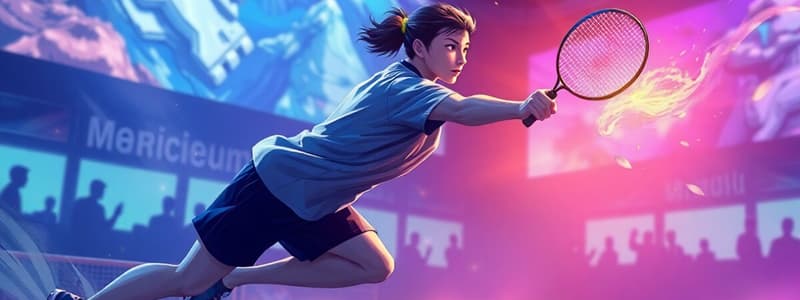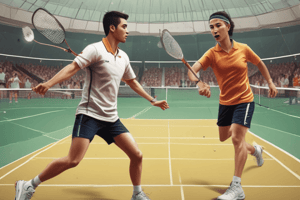Podcast
Questions and Answers
During the preparation phase, how does the player maximize force?
During the preparation phase, how does the player maximize force?
What biomechanical principle is demonstrated when the player fixes their right foot during the execution phase?
What biomechanical principle is demonstrated when the player fixes their right foot during the execution phase?
How does the player achieve linear motion during the execution phase?
How does the player achieve linear motion during the execution phase?
Which of the following describes how the player maximizes force during the execution phase?
Which of the following describes how the player maximizes force during the execution phase?
Signup and view all the answers
What biomechanical principle is used to improve the stability of the person's stance during the preparation phase?
What biomechanical principle is used to improve the stability of the person's stance during the preparation phase?
Signup and view all the answers
What is the primary function of raising the left arm during the follow-through phase?
What is the primary function of raising the left arm during the follow-through phase?
Signup and view all the answers
Which type of motion describes the movement of the racket during the follow-through phase?
Which type of motion describes the movement of the racket during the follow-through phase?
Signup and view all the answers
How does the person maximize force in the preparation phase?
How does the person maximize force in the preparation phase?
Signup and view all the answers
How does the player maximize force during the follow-through phase?
How does the player maximize force during the follow-through phase?
Signup and view all the answers
What is the purpose of the person's head and chest being angled during the preparation phase?
What is the purpose of the person's head and chest being angled during the preparation phase?
Signup and view all the answers
Which of the following statements accurately describes the role of angular motion in the preparation phase?
Which of the following statements accurately describes the role of angular motion in the preparation phase?
Signup and view all the answers
The biomechanical principle of stability is most evident in which phase of the serve?
The biomechanical principle of stability is most evident in which phase of the serve?
Signup and view all the answers
During the execution phase, how does the person maximize force?
During the execution phase, how does the person maximize force?
Signup and view all the answers
What type of motion is used to strike the shuttlecock during execution?
What type of motion is used to strike the shuttlecock during execution?
Signup and view all the answers
What is the primary factor that affects the shuttlecock's trajectory after it is struck?
What is the primary factor that affects the shuttlecock's trajectory after it is struck?
Signup and view all the answers
How does the person's stance change during the shift from preparation to execution?
How does the person's stance change during the shift from preparation to execution?
Signup and view all the answers
What is the purpose of the "Water Bottle Target Game"?
What is the purpose of the "Water Bottle Target Game"?
Signup and view all the answers
Which of the following is an advanced modification for the shuttlecock hot potato game?
Which of the following is an advanced modification for the shuttlecock hot potato game?
Signup and view all the answers
What is the main objective of the "shuttlecock hot potato" game?
What is the main objective of the "shuttlecock hot potato" game?
Signup and view all the answers
Which of the following is NOT an advanced modification for the "Water Bottle Target Game"?
Which of the following is NOT an advanced modification for the "Water Bottle Target Game"?
Signup and view all the answers
Which of the following is a beginner modification for the "shuttlecock hot potato" game?
Which of the following is a beginner modification for the "shuttlecock hot potato" game?
Signup and view all the answers
How long does each round of the shuttlecock hot potato game last?
How long does each round of the shuttlecock hot potato game last?
Signup and view all the answers
What is the purpose of the "Overhead Dynamic Triceps Stretch"?
What is the purpose of the "Overhead Dynamic Triceps Stretch"?
Signup and view all the answers
The water bottles in the Water Bottle Target Game are placed on the green stairs. Which of the following is true about the water bottles?
The water bottles in the Water Bottle Target Game are placed on the green stairs. Which of the following is true about the water bottles?
Signup and view all the answers
What is the purpose of the "Side lunges" warm-up exercise?
What is the purpose of the "Side lunges" warm-up exercise?
Signup and view all the answers
Study Notes
Sport Specific Handbook for Badminton
- Handout created by Otis Wong, PSK4U Kinesiology, Ms Z. Smith, January 23rd.
- Focuses on badminton techniques
- Covers serving, smashing, and internal/external factors
Chapter 1: Serving
- Discusses the biomechanics of serving in badminton
- Includes phases of movement, maximizing force, and stability
Phases of Movement (Serving)
- Diagrammatic representations of player's arm and leg positions during serving.
- Shows key actions like arm position, body twist, and leg movement in sequential steps.
- Descriptions of movements include; "arm in," "small top," "body straight," "legs straight," "twist," and "both arms out."
- Visual aids include diagrams and arrows outlining body placement and movement
Apply Biomechanical Principles (Serving)
- Preparation: Describes stability through wide stance (larger base) and maximization of force through full joint twisting (spine, arm, and wrists).
- Linear Motion: Shuttlecock's motion toward the opposite side of the net. Gravity causes the parabola shape.
- Angular Motion: Explains racket movement in a semi-circular pattern.
- Diagrams illustrate projectile type motion of the shuttlecock and circular racket movement
Execution (Serving)
- Stability: Maintains two points of contact (feet on ground) to prevent imbalance even while rotating, maximizing balance
- Maximizing Force: Large to small joint action, starting at the spine, right arm, and leg, and ending at the right hand.
- Linear Motion: Describes straight-line travel of the shuttlecock in the "x-axis," while gravity affects its downward movement in the "y-axis"
- Angular Motion: Discusses body and arm movements, and how angular momentum remains consistent
Follow-Through (Serving)
- Stability: Lifting left arm after serving, creating balanced stance with two points of contact.
- Maximization of Force: Right arm swinging forward, extending contact time with shuttlecock to maximize force.
- Angular Motion: Describes continued semicircular arm swing to complete the serve.
- Linear Motion: Continuing the shuttlecock's straight-line travel (in x-axis).
Chapter 2: Smashing
- The handout details the biomechanics of smashing in badminton
- Includes phases of movement, maximizing force, and stability
Phases of Movement (Smashing)
- Diagrammatic representations of players' arm and leg positions during the smash.
- Describes key actions like arm position, body twist, and leg movement in sequential steps (arm out, pointing up, slanted body, bent knee, large bottom, finished twisting, etc.)
- Visual aids include diagrams, arrows, and labels detailing actions
- Visualizes player positions, leg positions, and arm positions during the smash movements
Apply Biomechanical Principles (Smashing)
- Preparation: Full body twist maximizes force. The person spread apart his legs with foot facing outwards, causing a large base for their position with lesser change in falling over. Their left arm is pointing outwards.
- Linear Motion: Trajectory of the shuttlecock, a tilted line heading towards the other half of the court following gravity causing parabola
- Angular Motion: How the person angles their body and arm to fully swing the racket, and reaches a full rotation
- Diagrams illustrate projectile type motion of the shuttlecock and circular racket movement
Execution (Smashing)
- Maximizing Force: Large (spine, arms, leg, right shoulder, right calf), then small (right wrist) joint movement. The person twists his joints and body parts to first twist the spine, then the right shoulder, and calf anti-clockwise.
- Linear Motion: Linear trajectory of the shuttlecock after being struck, with gravity affecting the vertical direction.
- Angular Motion: Full body twisting and arm motions that complete a semi-circular movement to maximize power during the smash.
Follow-Through (Smashing)
- Stability: Description of the person lifting their right leg to balance with their right arm simultaneously after the action.
- Maximization of Force: The swing of the right arm when hitting the shuttlecock, that increases the time that the racket is in contact with the shuttlecock.
- Linear Motion: Shuttlecock travels in a straight line in a particular angle to the horizon, followed by gravitational pull
- Angular Motion: Person keeps turning his spine, and since his arm is attached to it, his arm follows a semi-circle pattern when striking the shuttlecock.
Chapter 3: Internal & External Factors
- Discusses internal (physical) and external factors influencing badminton performance
Two Individual Benefits of Participating in Badminton
– Physical Health: Badminton burns approximately 500 calories per hour, and the HIIT (High-Intensity Interval Training) nature continues calorie burn after the workout.
– Cognitive Function: The fast-paced nature of badminton improves reaction time, because player must react correctly at the right time to hit the ball back. This leads to solving complex problems easier.
Two Social Benefits of Participating in Badminton
– Increased Interpersonal Skills: Badminton involves paired competition and encourages mingling with a variety of people. – Enhanced Teamwork and Communication: teamwork requires cooperation and communication to work effectively.
One Barrier That Might Limit Someone's Ability to Participate
– Time Constraint: Accessibility to badminton courts. - Solutions include better scheduling. - Community solution: having a nearby court
Studying That Suits You
Use AI to generate personalized quizzes and flashcards to suit your learning preferences.
Related Documents
Description
This quiz delves into the specific biomechanics of serving in badminton, detailing the phases of movement and techniques to maximize stability and force. It covers essential actions, visual aids, and principles that are crucial for effective serving. Ideal for students of Kinesiology or badminton enthusiasts looking to enhance their skills.




